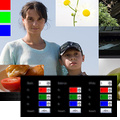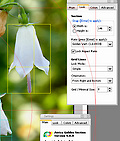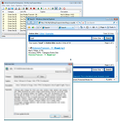Täglich bieten wir KOSTENLOSE lizenzierte Software an, die ihr sonst bezahlen müsstet!

Giveaway of the day — Atrise Lutcurve 1.3.1 Personal
Atrise Lutcurve 1.3.1 Personal war am 14. April 2009! als Giveaway verfügbar!
Dieses Programm hilft euch beim Kalibrieren eurer LCD- oder CRT-Monitore - ohne jegliche Hardware für 6500K gamma 2.2. Alle wichtigsten Features wie Anzeigeumgebung, Farbtemperatur und Gamma sowie die Möglichkeit des Fine Tunings sind mit am Bord! Referenzbilder und Echtzeit-Grafiken garantieren akkurate Einstellung auf jedem Kalibrierungsstadium
Features:
- Kalibrieren ohne Kalibrator - in wenigen einfachen Schritten!
- Akkurate Ergebnisse
- Keine Einschränkung für Kalibrierungs-Points
- Unterstützung mehrerer Monitore
System-anforderungen:
Windows 2000/XP/Vista/7, 32/64 bit; 32-bit color display mode; Video driver from manufacturer; Mouse or another pointing device.
Herausgeber:
Atrise.comHomepage:
http://www.atrise.com/lutcurve/Dateigröße:
1.78 MB
Preis:
$39.99
Weitere interessante Titel

Golden Section ist ein einziartiges Design Tool für Künstler, Programmierer, Fotografen und, natürlich, Designer! Es arbeitet im Einklang mit eurer bevorzugten Design Software und ermöglicht das Anwenden des Goldenen Schnittes für perfekte visuelle Ergebnisse!

Diese Javascript-basierte Suchmaschinen-Software ermöglicht Suche für Webseiten, CDs/DVDs, MP3/OGG Musik, Hilfe-Dateien. Das Programm indexiert die meisten Dateienformate und generiert multisprachige, ultraschnelle Suchmaschinen mit einem ansprechenden Interface.
Kommentare zum Atrise Lutcurve 1.3.1 Personal
Please add a comment explaining the reason behind your vote.
Although this software is a variant from the usual fare. I question the usefulness beyond just a slightly better color compensation program. Also the developer calls this a calibration, but to calibrate you need a reference instrument. In this case it would be a photometer for luminance and a colorometer for color temp and RGB value. You also would need a reference set like set reflectances and a color calibartion sheet to compensate for the illuminace of the room. If you want more control over your display do photo editing or something similar this would be a fine addition, with the right reference equipment this could serve as a means to calibrate but without that I really don't see a need to bloat your hard drive.
Also Installed fine on Vista Prem
Since most people's monitors are horribly out-of-adjustment, this is worth downloading for the manual alone. As I have a Media Center PC, I had already done a basic calibration of my monitors, so they didn't need much tweaking. Can this do what hardware calibration systems do? No, of course not. This is for basic adjustment. From the user manual:
Lutcurve is designed to provide optimal monitor display for these values:
Gamma:2.2, White Point:6500K, Luminance Level:80 cd/m2, Color Space:sRGB or native monitor color space.
The software is based on an article "Measurement of display transfer characteristic (gamma)" by A. Roberts. The calibration method is optimized for physiological sensibility of human eye to gray tones.
Note for color professionals: The software calibration method cannot give you color precision, because it does not take into account monitor RGB color coordinates. It is impossible to create correct ICC profiles without a measurement device.
PC display and color management are horribly complex. There are all sorts of issues with different devices and different applications. Here's a very small example of some of the settings: Vista color management settings (subset), refer to Windows Help and Support. NVIDIA color settings (subset), note also the options in the left panel.
Lutcurve doesn't address the full complexities of PC display and color management. It cannot be used with other gamma loaders, such as Adobe (standard restriction for this type of application). If you install it, you don't have to use it.
I wasn't able to trace the installation, because my installation tracing application crashes when comparing its snapshots. I doubt it clobbered files used by that application, as it was already open, and any DLL's, etc., that it uses would already have been loaded. Also, it didn't do anything bad to the registered DLL's. That utility has never crashed before, but the traces probably just exposed a bug; I'll use a file-sharing service and send them to the developer for analysis (after rebooting, in the unlikely event that that fixes things).
I am a software developer. First of all, thank you, a GAOTD community, for comments. I found some questions and misunderstanding here, so here is my comments and answers.
1. Lutcurve is safe to replace Adobe Gamma, because Lutcurve can be used with any icc profile. Operation system will use a profile created with Adode Gamma, and also a precise curve will be downloaded to your video card hardware. You can also safe use it with a Window 7 calibration feature.
2. The recommended here freeware programs, Adobe Gamma, Windows 7, Radeon and NVidia drivers have no feature to editing a monitor nonlinearity, so you will get much better image quality. Please read the software manual for possible advantages. Also, the program uses special methods to improve a quality of the visual calibration as a program specific.
3. If you want to get precise results, it is strongly recommended to use the program with a icc profile from a monitor manufacturer. Just look at the monitor CD to install it. Or search it in a manufacturer web site. The result will be very similar to a hardware-based results. Also some our users have reported better results than low-cost hardware calibrators, because your eye has better sensibility. A non-linearity is more perceptible in compare with a color error.
4. Users may report here no visual changes. But most general users have no experience in calibration and correct color corrections. So they may see no noticeable changes. These details very important for
image editing, printing and correction.
Also I know there is some old video cards those have no possible to download a LUT curve to the card. Also most of Microsoft drivers have no such feature. These users will see no any changes at all.
5. It is very important to place the software images on the center of the screen and on the central horizontal line for TN and S-PVA/MVA based LCD screens and laptops. So if your monitor menu covers the screen center, just move it. See the monitor manual for details. Also most monitors have advanced menu that already placed on a corner.
6. Almost all LCD monitors today need to be calibrated. Even NEC pro-series displays with a factory-calibrated curves have small nonlinearity that may be fixed with the program. Gamer or office monitors always have a 5-10% nonlinearity. Your monitor size and cost is not a factor to be sure about the monitor quality.
7. All the software bugs must be fixed. So if you have a crash or similar case, just contact to the support service. But in general, the program is stable.
8. The term "calibration" is correct. Color-space correction is "characterization". Hardware devices made two these actions. The program - only calibration.
I never used any such tool, but I really liked the way it worked.
Installed fine on XP and Easy to register.
A user friendly interface: Tabs at bottom from Welcome screen to different kind of tests.
User friendly instructions and controls to see the different aspects of your monitor.
Your monitor shows the immediate effect via color swatches (with options to type color value or use the navigation controls)
Can work with more than one monitor connected to your system. (I only had 1).
It displays online calibration result pixel by pixel. I liked the way it shows the gradient effects.
Overall it is a very informative and excellent piece of tool.
If color accuracy and the ability to match prints to your monitor are important to you, or you simply want the best colors you can get, I think having a decent hardware calibration utility is justified. Now if you’re seriously into digital photography then stuff like this is essential.
Right after the install, I did a basic run thru and was impressed by those results, especially the blacks. Then I reopened the program and begin the fine-tuning. The changes are done in real time, so there’s no waiting for it to process whatever adjustments you make (that’s a nice feature). After going thru the entire process my screen was significantly improved, it’s vibrant. So based on that experience I would recommend checking out this program to anyone wanting accurate monitor calibration.
Other sites that may be useful:
- If anyone cares to see whether their monitors could use some calibrating:
http://epaperpress.com/monitorcal/
- Online Basic Monitor Calibration can be had at:
http://www.displaycalibration.com/
- A good learning site about calibration:
http://www.drycreekphoto.com/Learn/monitor_calibration.htm


Sehr gutes Tool !
Hilft mir schneller (als von Hand), alle Moni's auf (fast) einen Level zu bringen !
Thanx, Gaotd !
Save | Cancel
so.. nochmal..
gutes programm..
nicht schlecht..
danke
Save | Cancel
@Andre
Kalibrierung und Eichung sind zwei paar Schuhe. Das Verfahren mag das gleiche (oder sogar das selbe) sein, Eichen darf aber nur das Eichamt (in DE) und das tut es mit hochgenauen Maßverkörperungen.
Kalibrieren darf jeder selber so viel er will. Womit, woran und worauf ist jedem selbst überlassen, also kann man das was dieses Programm tut zurecht Kalibrierung nennen.
Wie gut die nun ist: keine Ahnung. Für private Zwecke wirds wohl reichen, der echte Grafiker hat ohnehin ein ganz anderes Kaliber von Monitor bei sich zu stehn als wir zuhause...
Save | Cancel
seit 3 Jahre nehme ich mir vor, meinen Bildschirm zu kalibrieren, habe aber das Fachchinesisch dazu nie verstanden. Ich freu mich mich richtig über das heutige Programm! Danke GOTD!
Save | Cancel
@John F.
Also bei mir hat die Registration einwandfrei geklappt! Ich mußte auch nichts abtippen. Da wirst Du wohl etwas falsch gemacht haben!
Save | Cancel
ja das will ich doch auch meinen.
Kalibrierung ist eine Eichung eines Gerätes(Bildschirm,Meßgerät etc) und hat mit heutigen Pro.gramm nix tu tun!
Save | Cancel
Die Registrierung ist wirklich anstrengend, Kopieren und Einfügen funzt nicht.
Zur Registrierung den Link rechts oben anklicken.
Der Name lässt sich noch reinkopieren. Die Serien-Nummer muss abgetippt werden.
Save | Cancel
#John F.: Ja, sicher ist das alles schon eingebaut, aber die wenigsten wissen das und noch weniger verstehen das. Das Tool erleichtert die Arbeit ungemein...
Das einzige Problem ist, dass unsere berühmten Dummschwätzer das wohl nicht raffen werden...
Save | Cancel
Nicht schlecht.
Hatte meinen LCD wohl ewigkeiten falsch eingestellt gehabt.
Meine Digicambilder sehen jetzt nach der Kalibrierung viel besser aus.
Danke GAOTD!
Save | Cancel
Ziemlich mühsame Arbeit mit der Kalibrierung!
Programm von der Herstellerseite lässt sich nicht mit den Daten aus der ReadMe freischalten.
Alternative: http://www.hex2bit.com/products/index.asp
Save | Cancel
Ist doch alles schon im Grafikkartentreiber eingebaut, also wozu das ?
( NVidia-Systemsteuerung, ATI-CatalystControlCenter )
Und Drucker, Scanner & Monitor sollten schon gemeinsam kalibriert werden. Diese Tools sind allerdings dermaßen teuer, so dass ein par hundert Probedrucke billiger sind.
Save | Cancel
Und wenn der Bildschirm mit Atrise Lutcurve erst einmal schön kalibriert ist, können wir auch schöne Bilder und Wallpaper darauf geniessen:
http://blogorama.eisbrecher.net/2009/04/04/wallpaper-neuentdeckungen-im-april-2009
Und die Augen staunen!
Save | Cancel